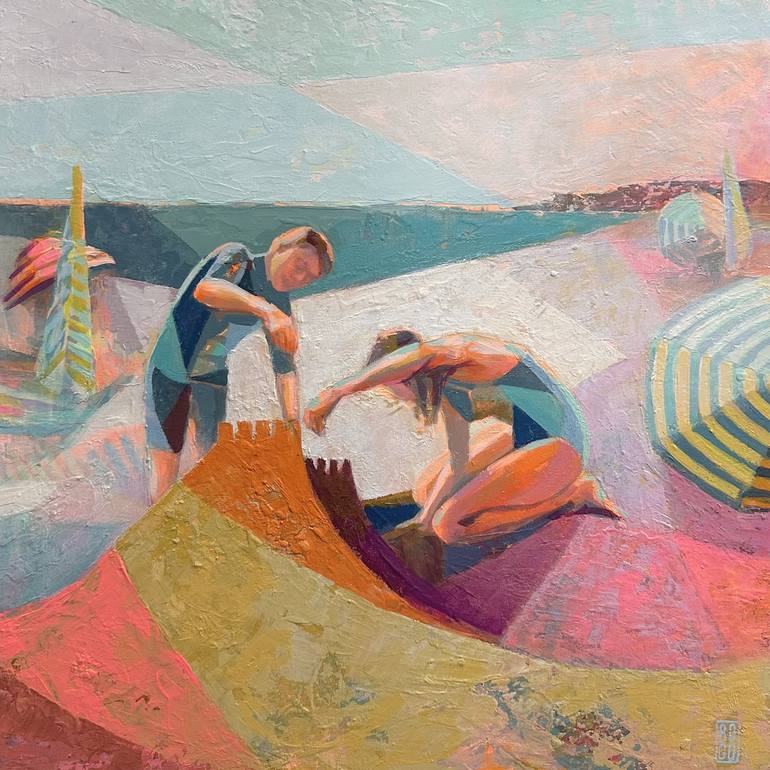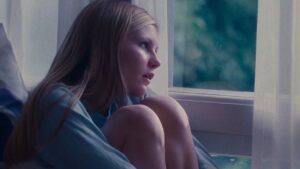
In the tempestuous painting Castle Commotion, Australian contemporary artist Bo Godiva offers an emotionally saturated vision of collapse and control, protection and provocation. The work—an acrylic and mixed media piece on canvas—commands attention with its architectural metaphors and its surging interplay between chaos and containment. Like much of Godiva’s recent work, Castle Commotion is both a visual spectacle and a psychological excavation: a castle not as a fortress of strength, but as a symbol of fragility under pressure.
To understand the painting is to place it within both historical and contemporary artistic lineages. Godiva, whose background spans both abstract expressionism and visual storytelling, fuses inherited traditions with an idiosyncratic vision shaped by Australia’s stark landscapes, urban intensity, and a post-pandemic preoccupation with internal and external turbulence.
The Architecture of Emotion
At first glance, Castle Commotion presents itself as a study in structural unrest. Hints of turrets, spires, and crumbling stonework emerge from a swirling fog of color and texture. But this is no literal castle; rather, it is an imagined space where history and identity, trauma and endurance, converge.
The brushwork is bold, almost combative, with strokes of charred umber, slate blue, and ashen grey layered over luminous washes of ochre and gold. These hues evoke both grandeur and ruin—a castle set ablaze from within, or perhaps collapsing not from siege but from surrender. Godiva’s use of palette knife scrapes, dripping lines, and impasto accents contributes to a sense of motion, the kind found in emotional unraveling or seismic social change.
In many ways, the painting is less about the castle itself than about the idea of commotion—the friction between what we try to defend and what threatens to undo us. This tension, embodied in the physical layering of the canvas, reveals Godiva’s deep interest in emotional architecture: how we build and inhabit metaphoric walls around our identities.
Material as Metaphor
Godiva’s approach to medium is deliberate and symbolic. Castle Commotion is constructed using acrylic, charcoal, and sand-infused gel mediums. The presence of sand—harvested from Western Australia’s Coral Coast—imbues the work with both literal and conceptual grit. As the artist explained in a recent interview, “Sand doesn’t settle. It shifts beneath you. I wanted that instability to live in the painting.”
The granular texture pulls the viewer into a surface that is both tactile and psychological. It invites inspection but resists clarity. Through material choices, Godiva ensures that the painting doesn’t just represent a commotion; it embodies one. The result is a canvas that feels alive with its own seismic language.
Castles in Art History
To paint a castle is to engage with a centuries-long tradition, one rooted in both European romanticism and medieval iconography. From Caspar David Friedrich’s ruined fortresses to Turner’s smoky silhouettes, the castle has symbolized everything from nationalist pride to melancholic memory. But where those artists often used the motif as a backdrop, Godiva pulls it center stage—and then pulls it apart.
In Castle Commotion, the castle is less monument than metaphor. Its partial visibility suggests erasure, reinterpretation, and psychological projection. It’s a shelter that fails to protect, a home that trembles with every emotional gust. Rather than romanticizing the architecture, Godiva interrogates its endurance. What do we preserve, and what do we let fall?
This interrogation connects Godiva to the postmodern tradition of deconstructing historical symbols. There are echoes here of Anselm Kiefer’s ashen, scarred landscapes or Doris Salcedo’s fragmented installations. But while those artists often center historical trauma, Godiva locates their commotion within the deeply personal—spiritual interiority rendered architectural.
The Australian Context
Though Castle Commotion speaks globally, it remains distinctly grounded in an Australian sensibility. Godiva, based between Melbourne and Perth, draws on both the harsh elemental power of the landscape and the shifting cultural tensions of contemporary Australian life. The vast, often alienating terrain of the continent serves as a backdrop to the personal psychic space represented in the painting.
Australia’s postcolonial dialogue also seeps into the work. The notion of castles—imported European structures associated with conquest, class, and control—gains new weight in a land where ancient Aboriginal structures, oral histories, and sacred geography predate such architecture by millennia. In this light, Castle Commotion can be read as a critique not only of personal fortresses, but of inherited, imposed ones—ideological and architectural alike.
Emotional Cartography
Godiva’s work often operates as a form of emotional cartography, mapping internal states onto outer structures. In Castle Commotion, the boundaries blur between what is built and what is felt. Walls drip like tears, spires melt into clouds, and windows seem to open onto nothingness.
This emotional instability is reflected in the viewer’s own movement through the work. There is no singular vantage point, no compositional center. Instead, the eye is drawn to whirlpools of color and pockets of texture, creating a feeling of being lost within the painting—as one might be lost within the self.
Godiva has spoken of painting as “a negotiation between protection and vulnerability.” In Castle Commotion, this negotiation plays out in real time. The structure may be ancient and fortified, but it remains permeable. Wind moves through the cracks. Memories echo in the walls.
Recent Trends and Reception
Castle Commotion was unveiled as part of Godiva’s 2024 solo exhibition “Fracture & Shelter” at the Art Gallery of Western Australia. Critics hailed the piece as a standout—a “storm of intimacy,” as one writer described it. Its timing was significant: released in the aftermath of a year marked by both global instability and personal recalibration, the painting spoke to a collective experience of holding on and letting go.
The wider art world has increasingly embraced work that navigates the boundary between emotional truth and formal experimentation. From Christina Quarles’ contorted figures to the architectural landscapes of Julie Mehretu, a common thread is the mapping of psychic states onto visual terrain. Godiva’s Castle Commotion fits squarely within this dialogue, but with a uniquely antipodean rhythm and a voice marked by poetic unrest.
Collectors and institutions alike have responded to the work’s layered resonance. Following the exhibition, the painting was acquired for the permanent collection of the National Gallery of Victoria, underscoring its cultural significance within Australian contemporary art.
Commotion as Clarity
In Castle Commotion, Bo Godiva achieves something rare: a painting that is both visually dramatic and emotionally precise. By marrying architectural imagery with raw, expressive abstraction, the work offers viewers not only a scene to behold, but a space to inhabit—a storm they must feel their way through.
The painting suggests that commotion, rather than being something to resolve or eliminate, can be a source of revelation. What we construct around ourselves—our defenses, our identities, our myths—may shake and fall. But in the collapse, something essential emerges. Something true.
In this way, Castle Commotion is less about destruction and more about transformation. The walls don’t just crumble—they speak.
No comments yet.








